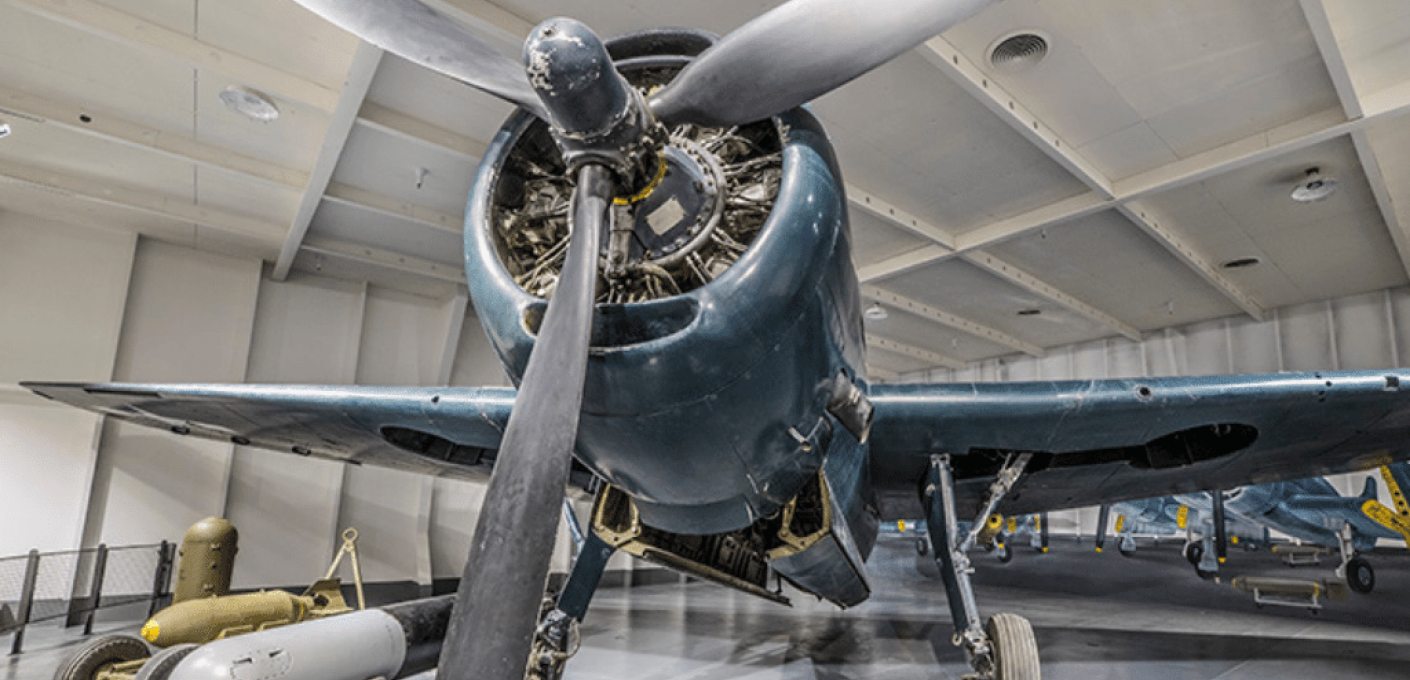
Permanent Exhibit
Pacific Combat Zone
This exhibit is a part of our permanent collection and can be seen with our General Admission tickets.
Overview
See what it was really like to do battle in the Pacific islands. We have replicated numerous aspects of the terrain, examples of the trenches and fortified cave positions that the Japanese had created to battle U.S. forces on those islands. Presentations at the Pacific Combat Zone include weapons and vehicles used during the Island Hopping campaign that our forces mounted.
The Pacific Combat Zone, just a short walk from the main Museum campus, gives visitors a diverse offering to explore. Upon entering, a map of the entire Pacific Theater of WWII (to scale) provides a bird’s eye view of the breadth of the journey to America’s eventual triumph. The Carrier Aviation exhibit provides an overview of the U.S. Navy’s challenges in the wake of the Japanese victory at Pearl Harbor that left the battleship fleet in ruins. The aircraft carrier became the best option for taking the fight to the enemy, and CINCPAC Admiral Chester W. Nimitz saw the need to adapt US Navy doctrine for carrier operations. The carrier task forces became the focal point of the surface fleet with battleships, cruisers, and destroyers in support.

TBM Avenger
Carrier-based aircraft provided the offensive punch in the Pacific War. Flight operations focused on the launch and recovery of torpedo bombers, dive bombers, and fighters for escort and carrier defense. During World War II, Grumman Aircraft Company, along with their partners, delivered more than 17,000 combat planes, including the TBF/TBM Avenger torpedo bombers which were the largest single-engine aircraft the U.S. flew in WWII and accounted for 55% of the enemy aircraft destroyed in the Pacific War.
General Motors began fabricating the TBM so that Grumman could focus on building more Hellcats. Grumman built 2,291 TBFs in 1942 and 1943, while General Motors built 7,546 TBMs beginning in 1943. The TBM Avenger on display here at the Museum was built in early 1945. While it was never used in combat, it was used for training the crews that would fly them.

PT (Patrol Torpedo) 309 Higgens Boat
The PT (Patrol Torpedo) Boat exhibit is designed to give visitors a sense of what it would be like to be aboard a PT tender that supplied and repaired PT boats. PT 309, a Higgins boat manufactured in New Orleans, is moored next to the tender.
Designed for torpedo attacks on much larger ships, PT squadrons fought in both the Pacific and European theaters. Battle experience showed that PT boats were most effective at interdicting small coastal supply craft.
There were PT boats at both Pearl Harbor and Manila when Imperial Japanese aircraft attacked. Armed only with .50-caliber machine guns, PT gunners claimed two low-flying torpedo planes as kills. Six boats lashed to the deck of an oiler bound for the Philippines managed to fire 4,000 rounds at the attackers. Thousands of islands and narrow water passages characterized the geography of General Douglas MacArthur’s Southwest Pacific Area where PT boats proved effective.
PT 309 – Oh Frankie - actually served in the Mediterranean, not the Pacific. In March of 2020, 94 year-old Dale Perry who had served on PT 309 visited the Museum. The former TM2c was allowed to board the vessel, which he declared was just as he remembered it. Perry told stories of his time serving on it to the small crowd that gathered including his family, Museum visitors and local press.

Iwo Jima Reenactment
The Living History Battlefield provides a realistic “set” for living history reenactments of battles between American and Japanese forces on islands in the Pacific. Upon closer examination, the battlefield itself is an informative exhibit that depicts a variety of characteristics, both natural and manmade that were encountered on Pacific Islands.
In the early 1980s, a small part of today’s battlefield was the site of a “history walk,” along which a few volunteers in uniform provided their own perspectives on aspects of the Pacific War. As time went on, staff and volunteers created a brief demonstration utilizing an operating tank and a flamethrower.
In the 1990s, the Museum created a small battlefield, in that previously ungroomed area, to stage more elaborate reenactments than the simple tank and flamethrower demonstrations. That original battlefield that was about 20% of the size of today’s battlefield. There were a few rows of bleachers provided for spectators who attended a reenactment of an “island assault,” which program continued through 2014.
Late in 2014, the Pacific Combat Zone was closed for its most recent, extensive renovation, which included upgrades to the Carrier Aviation and PT Boat exhibits, the addition of the vehicle building and amphitheater, and battlefield construction which resulted in the today’s configuration.
Since its reopening in March of 2017, it has been home to one of the most unique and elaborate, regularly scheduled reenactment programs which includes weapons demonstrations, musical entertainment and interactive presentations. The battle reenactment itself features troop deployment from an authentic LCVP (Landing Craft Vehicle Personnel) Higgins boat, shooting from an operating WWII Stuart tank and live fuel action using an authentic WWII flamethrower.

WWII flamethrower
The battlefield does not depict any one Pacific island but was designed with an array of features found on many islands such as a coconut log seawall and Japanese defensive devices such as bunkers, pillboxes and caves with hidden weapons. A distinguishing feature of our battlefield and reenactments are the number of authentic WWII artifacts on display or used in our demonstrations including:
- Japanese Type 90 75mm Field Gun
- Japanese Type 91 105mm Howitzer
- Japanese Type 1 47mm anti-tank gun
- Japanese Type 96 2-barrel antiaircraft gun
- Japanese Type 96 3-barrel antiaircraft gun
- American LVT-4 (Landing Vehicle, Tracked) AMTRAC (amphibious tractor)
- American LCVP (Landing Craft Vehicle Personnel) Higgins boat
- American Stuart tank

Stuart Tank reenactment



